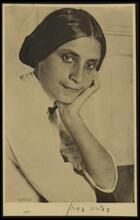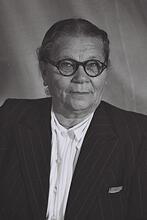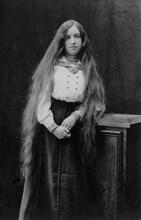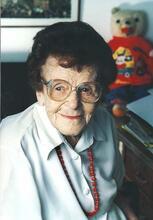Judith Katzir
Yehudit Katzir (b. 1963) is an Israeli author who emerged as leading female voice in what had been a male-dominated literary field until the 1980s. Her novels and short stories are noted for their idiosyncratic and lyrical language, as well as for their focus on female identity and treatment of taboo themes. Her works include several collections of short stories and novellas such as Closing the Sea (1990), as well as several novels including Dearest Anne (2003), Matisse Has the Sun in his Belly (1995), and the family saga Tzilla (2013). Touching on national and historical issues, Katzir’s works are personal as well as universal. On the one hand, she writes stories about childhood and coming-of-age, and on the other hand, historical and Zionist narratives.
Life and Debut Collection
Yehudit (Judith) Katzir is an Israeli novelist, short story writer, and editor. Her work includes novels, novellas, short stories, and a play, as well as children’s books. She has won literary prizes both in Israel and abroad, including the Book Publishers Association Gold and Platinum Book Prizes (1995, 1996, 1999, 2004); the Prime Minister’s Prize (1996, 2007); and the French WIZO Prize (2004). Written in Hebrew, her works have been translated into Arabic, Chinese, Dutch, English, Estonian, German, Italian, Macedonian, Polish, Portuguese, Russian, Serbian, and Spanish. Critics have identified her as one of the first Israeli women novelists to break into what had been, until the 1980s, a male-dominated literary field.
Katzir emerged as a leading voice in the first generation in Israel rich with female writers. Often concerned with female identity, adolescence, and childhood, her work is influenced by the tradition of stream-of-consciousness, and its syntax and long sentences set her apart from her contemporaries. Katzir is noted not only for her treatment of taboo themes but also for her pioneering style, characterized by a speaker who addresses a female addressee in second person feminine. Her language is richly idiosyncratic, sometimes even oxymoronic, combining lyricism and matter-of-factness. Her works were influential for the generation of writers that followed her. In addition to her work as a writer, Katzir has taught creative writing and worked as an editor at Hakibbutz Hameuchad/Siman Kriah Publishing House, where she has discovered and cultivated new literary talents.
Born and raised in Haifa, Katzir studied literature and cinema at Tel Aviv University and began publishing her stories in Israeli journals in the 1980s. Her first story, entitled “Disneyel,” was published in May 1988, in the journal Iton 77, and won the journal’s prize for best short story of 1988. One the judges, the author Hayim Bear, in his decision, described the story as “a moment of grace in Israeli literature.” Katzir published her first book, Sogrim et ha-Yam, a collection of four novellas, in 1990; this appeared in English as Closing the Sea in 1992. The collection received many critical accolades. One of the stories in this volume, “Schlaffstunde,” appeared in The Oxford Book of Hebrew Short Stories in 1996 and was adapted into a play as well as a film entitled Family Secrets (1997). The stories in Closing the Sea are written in the genre of bildungsroman, often depicting coming-of-age as a psychologically damaging process in which imagination is the only escape. “Disneyel” follows a girl as she witnesses the circumstances that bring her parents to a divorce. “Fellini’s Shoes,” another story in the collection, is about a late coming-of-age. The titular story, “Closing the Sea,” is a tale of an idealized adolescent friendship, betrayal, and disillusionment. This bittersweet story is about the necessity of growing up and no longer living in dreams. One of this story’s themes, exploring sexual identity, would be further developed in Katzir’s later novels.
Literary Treatment of Sensitive Subjects
Katzir is noted for her treatment of taboo themes. Her first novel, Le-Matisse Yesh et ha-Shemesh be-Beten (Matisse Has the Sun in His Stomach), was published in 1995. A bildungsroman with an oedipal premise, it simultaneously presents two seismic events in the life of its protagonist: an affair with an older man and the death of a parent. The protagonist, a 23-year-old student from Haifa, falls in love with a married professor twice her age, with whom she travels to Paris and who functions as a lover-father. Even as her mother is dying of cancer, she self-consciously repeats some of her mother’s own life events.
Katzir’s second novel, Hine ani mat’hila (literally “here I begin,” translated into English as Dearest Anne), was published in 2003 and caused some shock waves, in part because of its lesbian content. Set in the 1970s, it follows the 14-year-old Rivi Shenhar as she embarks on a years-long affair with her married female teacher. This lesbian relationship is written as a diary with letters addressed to Anne Frank. Rivi signs her diary entries “Kitty,” the name of Anne Frank’s imaginary friend to whom the title of the novel is also an allusion. Indeed, the story of Anne Frank is a recurring point of reference for Katzir. Most of the plot of Dearest Anne takes place in Katzir’s hometown of Haifa, a city that is for her both a setting and a character in its own right. In Dearest Anne, as in Closing the Sea, Haifa is not only a geographical space but also a feminine one, whose topography and colors parallel a beautiful woman’s body. Dearest Anne is not only a coming-of-age story and a sexual awakening story, but also an introspective look at the mechanism and psychological makeup of a nascent female writer. This introspection would later be developed by Katzir in a completely different genre when she explored the enigmatic female author Dvora Baron. Katzir’s only play to date, Dvora Baron is a close look at the psychology of the first Hebrew-language female author and was performed in 2000 at the Cameri Theater.
Israeli Cities and Zionist Ideology
Tel Aviv and Haifa, the two urban spaces that feature in Matisse Has the Sun in His Stomach, reflect Katzir’s life and emerge throughout her entire oeuvre. fact, two of her collections of short stories are titled Tel Aviv Stories (2008) and Haifa Stories (2005). In 1999, Katzir had published a book of novellas entitled Migdalorim shel yabasha (literally “lighthouses of dry land”). The protagonist of the titular story, Reuven Shafir, represents the expectations and disappointments of an entire generation. The story follows Reuven, who dedicates most of his life to serving the State of Israel. Reuven first serves as an agent of the Mossad bringing Jews from Morocco to Israel at the beginning of the 1960s and then goes on to be a labor lawyer fighting for workers’ rights. The climatic event, the assassination of Prime Minister Yitzhak Rabin, serves as a final blow. At the core of this story lies the theme of the intertwining fates of the Jewish individual and the unfolding Zionist narrative.
This theme eventually came to the survey in Zillah (Tzila, 2013), Katzir’smost mature, complex, and ambitious work to date. This polyvocal novel takes real figures as its central characters and at the same time mythologizes them against the backdrop of Eretz Israel at the beginning of the 20th century. Zillah won the Culture Minister’s Zionist literature prize. The plot of this hybrid novel spans over four generations as it moves between fiction, family saga, memoir, and autobiography. Zillah is based on the notebooks of Katzir’s great-grandmother, Tzila Remberg-Margolin (1883-1967), documenting 30 years of her own life. After losing her eye in the 1905 pogrom in Odessa when she was hit in the head by an axe, Tzila and her husband Eliezer travel to the Land of Israel where they have five children while wandering from one settlement to another. In one of these places, Tzila meets and falls in love with Hannan Remberg, a pioneer from Warsaw nine years her junior whose noble nature is in striking contrast with her husband’s coarseness. The novel follows this courageous heroine as she prevails over poverty, Arab attacks, and family turbulence, while living with two men in the same household. After her husband dies, Tzila marries Hannan. All the while, Tzila’s own children greatly admire her and keep this family secret.
The Personal and the National in Katzir’s Work
The novel Zillah provides an underexplored female perspective on the Jewish settlement in Palestine, just as Katzir’s earlier works likewise often emphasized the female voice as part of a broader historical or cultural narrative. “Schlaffstunde” and Dearest Anne, for example, evoke the Holocaust as it shapes the consciousness of their protagonists. Her fascination with this tragic period in Jewish history did not stem from her educational background. In fact, Katzir noted in an interview that, growing up in Haifa in the 1960s and 1970s, Israeli schools did not teach children about the Holocaust. At the same time, she said that the event “was like a nuclear cloud above us, above our heads” (Penn Today, October 30, 2019).
The Holocaust is one of the two major events in Jewish history of the 20th century, the other being the establishment of the State of Israel. Unlike the Holocaust, the history of the settlement in the Land of Israel and the battles fought for it was very much a part of the educational curriculum. Moreover, these two events are inscribed in Katzir’s own biography. Underlined by these historical and national considerations, Katzir’s works are at once intimate and universal. On the one hand, there are personal stories about childhood, coming of age, and maturation, and on the other hand, in the background—and sometimes in the foreground—is the national narrative, whether it is connected to the Holocaust, to immigration or aliyah, to the Zionist settlement, or even to the city of Haifa. Katzir’s home city, Haifa itself merges both the personal and the broader threads.
Selected Works
Dearest Anne. Translated by Dalya Bilu. New York: The Feminist Press at CUNY, 2008.
Sogrim et ha-yam (Closing the sea). Tel Aviv: Hakibbutz Hameuchad, 1990.
Closing the Sea. Translated by Barbara Harshav. Harcourt Brace Jovanovich: 1992.
Le-Matisse yesh et ha-shemesh be-beten (Matisse has the sun in his stomach). Tel Aviv: Hakibbutz Hameuchad, 1995.
Migdalorim shel yabasha (Lighthouses of dry land). Tel Aviv: Hakibbutz
Hameuchad, 1999.
Dvora Baron. Tel Aviv: Hakibbutz Hameuchad, 2000.
Hinei ani mat’hillah (Here I begin). Tel Aviv: Hakibbutz Hameuchad, 2003.
Sippurey Heifa (Stories of Haifa). Tel Aviv: Hakibbutz Hameuchad, 2005.
Tel Aviv (Stories of Tel Aviv). Tel Aviv: Hakibbutz Hameuchad, 2008.
Tzila. Tel Aviv: Hakibbutz Hameuchad, 2013.
Abramson, Glenda, ed. The Oxford Book of Hebrew Short Stories. Oxford and New York: Oxford University Press, 1996.
Berger, Michele W. “An Intimate Conversation with A Famed Israeli Author.” Penn Today, October 30, 2019. https://penntoday.upenn.edu/news/intimate-conversation-famed-israeli-au…;
Gold, Nili. “The Topography of the City and the Body: Yehudit Katzir’s Haifa.” Hebrew Studies, Vol. XLVII (2006): 281-294.
Gold, Nili. Haifa, City of Steps: The Landscape, Literature and Architecture of Hadar HaCarmel. Hanover and London: Brandeis University Press/University Press of New England, 2017.
New Library / Hakibbutz Hameuchad. “Sogrim et ha-yam.” April 23, 2020. https://www.newlibrary.co.il/product?c0=13060&BSP=12838.









